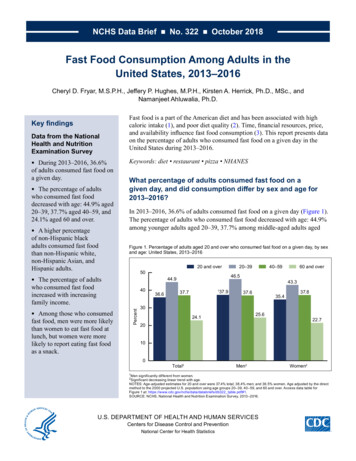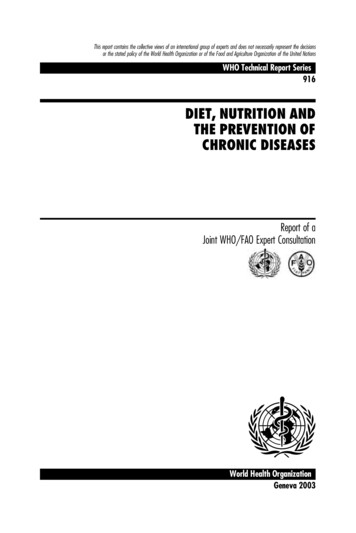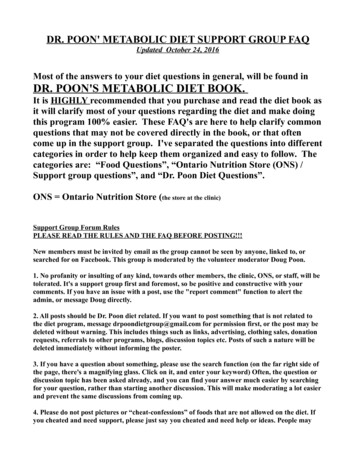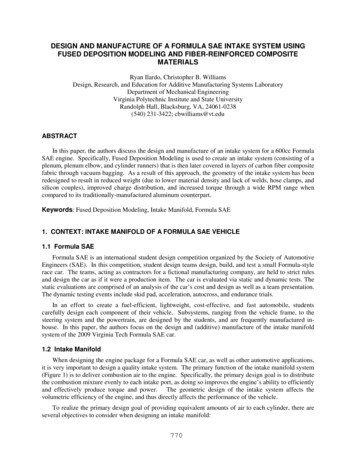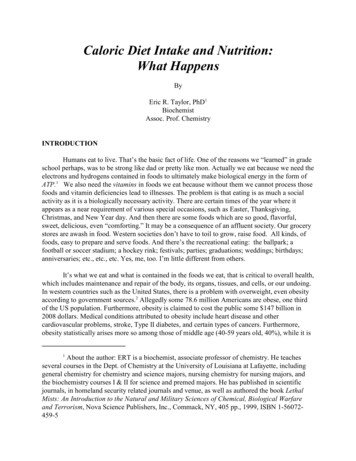
Transcription
Caloric Diet Intake and Nutrition:What HappensByEric R. Taylor, PhD1BiochemistAssoc. Prof. ChemistryINTRODUCTIONHumans eat to live. That’s the basic fact of life. One of the reasons we “learned” in gradeschool perhaps, was to be strong like dad or pretty like mon. Actually we eat because we need theelectrons and hydrogens contained in foods to ultimately make biological energy in the form ofATP.1 We also need the vitamins in foods we eat because without them we cannot process thosefoods and vitamin deficiencies lead to illnesses. The problem is that eating is as much a socialactivity as it is a biologically necessary activity. There are certain times of the year where itappears as a near requirement of various special occasions, such as Easter, Thanksgiving,Christmas, and New Year day. And then there are some foods which are so good, flavorful,sweet, delicious, even “comforting.” It may be a consequence of an affluent society. Our grocerystores are awash in food. Western societies don’t have to toil to grow, raise food. All kinds, offoods, easy to prepare and serve foods. And there’s the recreational eating: the ballpark; afootball or soccer stadium; a hockey rink; festivals; parties; graduations; weddings; birthdays;anniversaries; etc., etc., etc. Yes, me, too. I’m little different from others.It’s what we eat and what is contained in the foods we eat, that is critical to overall health,which includes maintenance and repair of the body, its organs, tissues, and cells, or our undoing.In western countries such as the United States, there is a problem with overweight, even obesityaccording to government sources.2 Allegedly some 78.6 million Americans are obese, one thirdof the US population. Furthermore, obesity is claimed to cost the public some 147 billion in2008 dollars. Medical conditions attributed to obesity include heart disease and othercardiovascular problems, stroke, Type II diabetes, and certain types of cancers. Furthermore,obesity statistically arises more so among those of middle age (40-59 years old, 40%), while it is1About the author: ERT is a biochemist, associate professor of chemistry. He teachesseveral courses in the Dept. of Chemistry at the University of Louisiana at Lafayette, includinggeneral chemistry for chemistry and science majors, nursing chemistry for nursing majors, andthe biochemistry courses I & II for science and premed majors. He has published in scientificjournals, in homeland security related journals and venue, as well as authored the book LethalMists: An Introduction to the Natural and Military Sciences of Chemical, Biological Warfareand Terrorism, Nova Science Publishers, Inc., Commack, NY, 405 pp., 1999, ISBN 1-56072459-5
less problematic among the young (20-39 years old, 30%), or the elderly (over 60 years old,35%). Additionally, obesity is highest among non-Hispanic black citizens (48%), then Hispanics(43%), then non-Hispanic whites (33%), and bringing up the end, non-Hispanic Asians (11%).It is not the purpose or intent of this treatise to “point the finger” or find fault with anyonewho battles waistline issues. Rather, it is the intent to educate and arm the individual on thesalient points about human metabolism and nutrition and how certain food molecules areprocessed, and do so in a manner that is understandable, informative and most importantly,useful. Much of what we do dietarily speaking is a result of ignorance– not knowing, certainlynot understanding, what and why it happens, in some cases anyway.Metabolism is a term used in biology and chemistry to encompass a range of biochemicalreactions occurring in cells and/or whole organisms (human body) that make use of foodmolecules to build body molecules (muscle, blood, hair, etc.) and to produce energy. The sumtotal of chemic al reactions that occur to produce energy are termed catabolism, while those thatproduce body mass components (muscle, hair, hemoglobin, body fat, etc.) are termed anabolism.These two processes occur simultaneously, though anabolism is generally energy dependent,meaning, it requires energy produced from catabolic processes to fuel the anabolic processes tohappen. If you run or jog, you build muscle. But building your leg muscles requires proteinintake from your diet to provide the amino acids needed to build your muscle, and the energy isprovided by the carbohydrates also in your diet.Each person has a rest metabolism, a minimum rate at which their metabolic reactionsoccur while completely at rest, while awake, and at 20 C (78 F). This basic metabolic rate iscalled the basal metabolic rate.3A BASIC LAW of CHEMISTRY & PHYSICS versus DIETINGThe word matter is a term that means the material of which all things are made. In highschool you learned about atoms and these are matter. But atoms combine to make molecules ofsubstances we encounter each day in our lives such as water, metal alloys, and food componentssuch as starch, proteins, fats, and carbohydrates. As it pertains to living organisms such as abacterium, your pet dog or cat, or you, your body, an important applicable law of chemistry is theLaw of Conservation of Matter. This law has a direct bearing on dieting. The law states in somany words, that matter cannot be created or destroyed through ordinary chemical processes.4Dieting practices comply with this law. If you take in more calories than your body needs for aday, the excess will be stored most likely as body fat. If you take in fewer calories than your bodyneeds for a day, it will most likely make up the decreased calories needed by accessing andburning body fat. For an organism to gain mass5 (weight), it must ingest matter (food stuffs) inexcess of its metabolic needs. The adage: I just have to look at that slice of pie and I gain weightis totally false. For one to gain weight from the slice of pie, it must first go past your teeth.THE DIETETIC CALORIEThere is a significant push in society to label foods with among other information, theircaloric content. You undoubtedly have seen these listings on labels as for example: serving size
one eight slice pie, Calories: 330. There are two kinds of calorie measures– one formerly used byscientists (who now use the joule), and one used by dietitians. The scientific or thermodynamiccalorie is spelled with a small “c”, while the dietetic Calorie is spelled with a capital “C”. Thedietetic Calorie is actually 1000 times larger than the thermodynamic calorie. So, that one eighthpie slice that claims 330 Calories is actually 330,000 thermodynamic calories. And since eachthermodynamic calorie is 4.184 joules, that pie slice comes in or should I say goes down (thethroat) as 1,381,000 joules. That’s a lot of calories. However, you label it!If we consider a 200 lb male and ask, how much water could his daily caloric intake, tomaintain his body weight, bring to a boil from room temperature (25 C)? Such a calculationwould reveal that if all his caloric intake were actually converted to heat, it would raise thetemperature of almost one US gallon of water from 25 C to the boiling point of water (100 C).6DETERMINING DAILY CALORIC NEEDA good starting point for assessing your dietary intake is to first know just what is yourdaily caloric intake need. There are a number of equations that can be used to determine dailycaloric need, but they are equations, and one has to plug existing weight, age, height, etc. intothem, and it’s a mess to do. There is a simple way, not perfect, but workable. Men can take theircurrent weight and multiply it by 11. Women can similarly take their current weight and multiplyby 10. So, if you are a male and weigh in at 200 lbs, your daily caloric intake to maintain that 200lbs is 11 times that weight or 2200 Calories. For a woman weighing in at 160 lbs, her dailycaloric intake to maintain that weight is ten times that weight, or 1600 Calories.Let’s employ an example of gain and loss that is basic and understandable even in a smallsimple equation- your checking account. Here’s the equation I’ll use:B D - W where B is the balance in dollars, D is the deposits in dollars and W is the withdrawals indollars, the dollar value of checks written to creditors. Clearly if you can reduce W , whilemaintaining the deposits D , your balance B will increase. But if you start writing a bunch ofchecks W without increasing D , your balance B will decrease. A similarly simple equationcan be used for body weight.One’s body weight is a function of caloric intake minus caloric burn and the basalmetabolic burn. By caloric burn I mean calories you burn from physical activity for your currentweight. I offer the simple equation:W Ci - Cb - MbWhere W body weight, Ci is caloric intake, Cb is caloric burn and Mb is your basal metaboliccaloric consumption. Clearly if Cb is zero and Ci is greater than Mb, you will gain weight. Onthe other hand, if Ci is less than both Cb and Mb combined, you will lose weight. If Ci is equal tothe sum of Cb and Mb, your weight will in principle remain static.
DIETING– THE DON’TSI think it is reasonable to say that we Americans tend to be somewhat impatient. We wantit now. We want it done now. Dieting seems to suffer from this impatience also. We want to losethe weight now. Well, one does not necessarily put weight on literally over night, and onecertainly will not lose all the weight literally over night. But herein is the first problemconfronting us, a psychological feature to weight loss.Think for a moment. Think of any occasion in your life where “losing” anything was agood thing to happen? We have been conditioned throughout our lives to regard loss as bad.From the mundane of losing the car keys, to losing money, or losing freedom, to the more tragicof losing a loved one or your health, none of it is a good thing. Yet now, with dieting, “losing”weight is supposed to be good. The brain says NO! Losing weight is not good. To the brain,weight loss is a “red flag.” Something is wrong. There are a host of hormones that come into playwith regards to metabolism, and certainly as well in weight loss, and especially “precipitous”weight loss, which all too often, people attempt to do at a drastic and unsustainable level. Thebrain reacts. A host of signals are sent out. The “hunger pangs” are a clear signal that the brain iswell monitoring your body and “finds” this state of affairs inadvisable. It is prodding you to eator increase your caloric intake. To reduce the difficulty of “losing” weight, one must “outsmart”the brain for any diet plan to be effective, to work, and not become a daily exercise in self-torturefrom the hunger pangs.Another issue with dieting is the propensity of many people to weigh themselves nearlyevery day. This borders on psychological terrorism of oneself. Weight will fluctuate on a day today basis. Some days you are more active than others, other days you didn’t eat as much as younormally may do, etc.Another matter concerns our own habits. We have become conditioned to doing what wewant in our earlier years, but as we age, and often find physical activity decreasing or limitationsimposed upon us, some of our youthful habits, such as eating what we want and when we want,and all too often, too much of what we like, we tend to continue doing so. Holidays and otherspecial occasions certainly contribute to this. It is hard to break a lifetime of habits. But likecaloric intake, such habits may not be easily altered or broken. It takes time, a methodicalapproach, and determination. You won’t discard a life’s worth of habits overnight anymore thanyou acquired those habits overnight. You may find it useful to pick a habit and focus on it,consciously reducing its frequency over time. In other words, cultivate a new habit. For most ofus, “going cold turkey” as the saying goes, is just this side of impossible. Break it in, but do sowith determination and as reasonably quickly as you can actually sustain successfully limiting thehabit itself while redirecting to a new habit.And along this line, is the issue of some diets of decades past advocating cutting certainfoods out. Not a good idea. Especially carbohydrates and fats any more than you should cut outprotein from your diet. However, you can reduce how much carbohydrate or fat you ingest eachday.DIETING– THE DOS
Clearly if a person has some significant medical issues, that person should discuss theircondition with their physician as to caloric intake reduction levels, as well as what kind ofexercise is OK for their condition. Assuming that there are no underlying cardiovascular,respiratory, or orthopedic, etc. conditions imposing limitations on the person, the following is anapproach that should work reasonably well. I say should, if it is followed without “cheating.” [Asit pertains to dieting, we all tend to “cheat” a little. Once in a great while is not necessarily aproblem, but if it is daily, you are defeating yourself daily.]In any diet plan, the physicians and dietitians strongly advise an exercise program. Theyurge at least a daily 30 minute physical activity such as walking, jogging, bicycle riding, etc. Andif you are doing some kind of exercise activity for at least 30 minutes aday, and actually working your muscles and body, and controllingcaloric intake, you will be replacing body fat with muscle. Muscle istwice as dense as fat. This means that as you burn off body fat, you arereplacing some of it with muscle. Thus, your weight may actuallyshow a slight increase over time during periods of fat loss, and yourweight may show a stabilization or slight increase. So weighingyourself each day is not a good idea, and its not a good measure ofsuccess. Now, if you are significantly over weight, yes, for the shortterm, a reasonable diet control will show a generally steady weight loss. But as that reallyexcessive body fat weight is lost, and muscle is built from exercise, the rate of weight loss fromfat itself, will decrease as your activity and body weight approach the “new, lower” body weightfor the caloric intake and caloric burn levels you are currently at.A drastic cut back in caloric intake is a no success approach. A better approach is to cutback slightly. Determine your current daily static caloric need for your current weight, and reducethat intake by say 5%.7 For our 200 lb male that is a reduction of 100 Calories in nice roundnumbers. For our female it is 80 Calories. Does this mean I have to know the caloric content ofeach portion of carbohydrate, meat, fat dish? Well, yes, how else can you adjust your dailycaloric intake if you don’t know how many calories each item serving you ingest has? However,it is only a “bother” at the beginning. As you determine the caloric content of that quarter poundhamburger, that half cup of potatoes, the three teaspoons of your favorite salad dressing, etc., youknow that data for subsequent meal inclusions of those foods. BUT, you must know the sum totalof calories on your plate for each meal for each day, and if you really want to lose some weight,you must reduce your total daily caloric intake BELOW your current weight calories value(calculated as shown above).Does this mean that you can eat whatever you want? Yes and no. Any dietary restrictionsthat your physician has advised you follow should not be ignored. But weight gain is not afunction so much of anyone thing you eat, but rather how much of it you eat in one day inaddition to regular meals consumption– meaning the snacking through the day, or that fast foodgreasy spoon loaded hamburger and those large double order fries. [Those kind of foods in onesitting can easily exceed your total allowable caloric intake for the entire day!]It is useful to keep the weight equation above in mind. It says your weight gain or loss is afunction of everything you ingest throughout the day, minus your basal metabolic burn minus any
physical exertions you do. If that caloric intake exceeds your basic metabolic rate and theexertion caloric burn, then you not only can expect to gain weight, it should not be a surprise todo so as seen on the bathroom scale. If you really like that chocolate ice cream with the chocolatesyrup on it, and your physician hasn’t advised to you leave it alone completely, you may havesome, but be reasonable about the portion size and calories of it you take in. It and the calories ofeverything else you eat that day must be less than your weight times 11 (if male) or 10 (iffemale).In conjunction with that reduction in caloric intake, increase your physical activity. Dosomething that is permissible for you and works your muscles– walk, jog, ride a bicycle, or ifpossible for you, cut the grass with a non-riding lawn mower as examples. Table 1 lists severalactivities and the caloric burn for that activity per minutes duration indicated.8Don’t weigh yourself daily. At the most, weigh yourself once a week. Pick a convenientday, perhaps in the morning before any breakfast. But a better measure would be to use a tailor’stape measure to measure yourself around say your waist, or your thighs, some place where youknow weight accumulates. This is better as you lose body fat, the girth of that location shouldshow a decreasing overall length on that tailor’s tape measure. And, and this is equally importantfrom a psychological viewpoint, don’t expect or insist on dramatic decrease changes. It isn’t somuch how much weight you lose in a week or month, or how smaller the girth measurement iseach week or each month. It is that it IS less, and it remains off, and you don’t feel like yourstarving yourself during the process!PRINCIPAL DIETARY ISSUESOver the past few or several decades, there have been a number of diet programs thathave touted their ability to help you lose weight. Some have even advanced the notion that youshould cut out carbohydrates or fat, or whatever. I have no intention of going into them as fromthe start, most violate serious principles of biochemistry and are potentially dangerous to somepeople with serious medical conditions, though perhaps fortunately, most people don’t stick toany such diets, perhaps dropping off of them before any real harm can set in, by themselves or ata physician’s directive. But there are a few facts at this point that should be borne in mind at alltimes when embarking on any diet program.First, it is true that carbohydrates (in excess intake) are converted to body fat (chemicallyclassified as triacylglycerols or triglycerides). Biochemically this is because humans haveevolved to use carbohydrates as the first principal energy source, and they are so plentifulthroughout the “food environment” (corn, rice, potatoes, etc.). Additionally, the energy possessedby carbohydrates (think in terms of glucose here) is considerable for such a small molecule, andthat energy if “consumed” but not needed is not discarded. The body cannot store much glucose(other than in liver or muscle as glycogen– animal starch), so it converts the excess, unusedglucose to fatty acids (long carbon chain carboxylic acids) and then attaches those to glycerol tobecome the body fat that is deposited to fat cells (adipose tissue) and stored for a “rainy day”,meaning when you need energy and carbohydrate intake is below sustainable levels.Second, the avoidance of fat is an iffy issue. There are what are called essential fatty
acids, fatty acids that the human body cannot produce through any human anabolic processes, butare absolutely necessary for body cells. The brain is one organ that has a need for certainessential fatty acids. Historically, the development of the human brain has been at least looselytied to the ingestion of meat and animal fat sources, resulting in an increase in brain size fromsome 450 cm3 of the Australopithecinae to about 1350 cm3 of today’s Homo sapiens over some3.5 million years.9 So cutting fats out entirely, though on the one hand most likely impossible, onthe other hand, may be nutritionally harmful. Having said that, ingestion of excess fats is not agood idea any more than ingesting copious quantities of carbohydrates is a good idea.BALANCE. That’s the watch word for any diet. Fats are one of the “flavoring” components ofvarious foods. A hamburger tastes so good because of the fats in it, that during cooking, arechemical altered giving the flavor that attracts us. One of the problems with low fat foods is thatwith reduced fat, reduce flavor automatically follows. One way processed foods manufacturersget around this is to add sugar, a carbohydrate. Sweetness also attracts us. The “sweet tooth”actually isn’t a tooth in our mouth. It’s the brain that is the sweet tooth.” Its primary andpreferred energy source is glucose, a component of sugar.Then there is the biochemistry of the carbohydrates versus fats issue. Let’s examine thisbelow as a result of other important considerations that arise as well.THE HIERARCHY of BIOCHEMICALS of FOODSFoods fall into four major classes of biochemical substances. Those four classes are (a)carbohydrates, (b) lipids (including fats), (c) proteins (including amino acids), (d) nucleic acids(DNA and RNA).10 Of these four classes the first two are of considerable importance incatabolic reactions performed by cells to produce energy. Carbohydrates come in several forms,but for humans the two most common and important forms are starches and sucrose (tablesugar). While half of a table sugar molecule is glucose (a simple aldohexose monosaccharide),the other half being fructose (a simple ketohexose monosaccharide), starch is a branched polymer(generally looks like a tree) of glucose. Starches are the major component of food crops such asrice, corn, and potatoes. In the plant world another major polymeric carbohydrate also isprominent. It is cellulose. There are significant differences in how the glucose molecules arejoined in starches compared to cellulose, but cellulose unlike starches has no branches, it is alinear (like a string) only polymer molecule.11 The long stingy strands of celery offer a largescale hint of what the cellulose molecule is like.Humans have evolved to make use of carbohydrates (glucose) as a principal energysource. If carbohydrates are absent or insufficient, fats are the second fall back principal energysource. The presence or absence of glucose in the diet dictates just what of the biochemicalreactions (called pathways) will or will not operate at full effect. This has significant impact ongeneral health, and even in certain cases of pathology such as diabetes (types I or II). So how is itdetermined to use what you eat, and what happens to it all?ROLE of PANCREATIC HORMONES and CARBOHYDRATESUsually, any meal humans ingest contains carbohydrates, proteins (meats, fish, beans,etc.), and fats as the major components of the matter ingested. Clearly, they are not necessarily
balanced in portions, or daily recommended amounts of each, etc. The carbohydrates as notedabove consist mainly of glucose (starches) and as a result of digestive processes starting in themouth (chewing, "-amylase), the starches are broken down until in the small intestines, glucosemolecules are released in copious quantities. The glucose is absorbed into the blood stream anddue in part to brain hormones responding to the fact, the pancreas secretes the protein hormoneinsulin.Insulin is a hormone that basically signals a fed state, meaning it tells the liver tissue cellsyou have eaten. Now here’s the fine print on this. The “fed state” really only means you haveingested a glucose source (cellulose will not trigger release of insulin, so it is not a source ofglucose for humans.12 If you had ingested a meal of only rice, the same response by the pancreaswould be elicited. The inability of the pancreas to synthesize and release insulin in the presenceof high blood glucose levels beginning at an early age such as adolescence is the basis fordiabetes Type I or juvenile onset diabetes. Insulin has a number of significant effects on cellsespecially liver. [The human liver is a remarkable organ with a number of critical biochemicaljobs to perform on behalf of the human body. More of this later.] Insulin has the followingeffects:1. signals a fed state (only if carbohydrate specifically is ingested)2. increases cell permeability for glucose absorption into cells3. increases cell permeability for amino acid absorption into cells4. favors the process called glycolysis (carbohydrate, glucose burning), which isthe biochemical processing machinery (pathway) for catabolicallymetabolizing glucose leading to the production of energy in the form ofATP (Figure 1 shows an abbreviated glycolytic pathway for thoseinterested in the process.)5. disfavors fatty acid utilization (called -oxidation, burning fat)6. suppresses (muscle) protein breakdown (called proteolysis, breakdown of bodymuscle; digestion of dietary proteins is governed by a different set ofenzymes and hormonal signals)7. disfavors glucose synthesis (gluconeogenesis). [In absence of glucose intake,many other biomolecules resulting from metabolism can be converted toglucose. Insulin suppresses this process as insulin secretion is a signal thatblood glucose is high from ingestion.]8. favors fatty acid synthesis from excess, unused glucose (this is the carbohydratebecomes fat point)9. favors synthesis of liver (hepatic) glycogen (glycogenesis) from excess,unneeded glucose intake (from carbohydrate sources such as starch)
10. counters the effects of the other pancreatic protein hormone glucagonGlucagon13 has the following effects:1. signals energy (intake) deficient state (in control in absence of carbohydrateingestion or blood glucose levels are below normal)2. allows proteolysis3. disfavors glycolysis4. favors -oxidation of fatty acids from breakdown of body fat (triacylgycerols)from adipose (fat) tissue; becomes the major source of fuel molecules toproduce the energy molecule ATP under low glucose ingestion5. favors gluconeogenesis (glucose synthesis) from certain amino acids (resultingfrom proteolysis14 ) and other simple precursors6. favors breakdown of liver glycogen (glycogenolysis) to release liver glycogenglucose into the blood streamIt is the ratio of insulin/glucagon that determines what will happen metabolically withcarbohydrate ingestion. If the ratio is high, insulin is in charge so to speak and the process ofglycolysis is in full gear. If the ratio is low, glucagon is in charge and glycolysis is disfavored, butmetabolism of fats is favored (even amino acids as well).15ROLE of LIVER in ALL of THISNo one organ is supremely important or critical as the body is an integrated system, allorgans and tissues performing their own and generally unique duties, all of which are absolutelynecessary for the maintenance, repair and sustaining of the whole. But the liver has a number ofimportant functions that are in of themselves critical to overall health and in the event of liverdisease or even failure, the consequences are obvious and lethal if uncorrectable medicallyspeaking. Jaundice is an indiction that something is not right in the liver.The liver performs several functions:1. It is the site of detoxification of harmful chemical substances, and evenbreakdown products of some biomolecules no longer needed by the body. All medications end upin the liver for biochemical processing rendering them less toxic and more soluble for excretionin urine. This is not fool-proof. Some substances may actually be processed to a more harmfulbyproduct, or so much of a substance may be ingested that it overwhelms the liver’s capacity toprocess all of it. An example of these issues is the active ingredient in Tylenol, acetaminophen.Another example is cyanide. Some foods have small amounts of cyanide in them which isprocessed by the liver, producing thiocyanate, a cyanide derivative that is about 300 times lesspoisonous than cyanide.16 However, the liver cannot detoxify large amounts of cyanide.
Pathogenic chemical substances also are processed in the liver for detoxification. Anexample is the pyrolytic (burning) byproducts of organic material such as benzo[a]pyrene, apolyaromatic hydrocarbon and known chemical carcinogen.17 However in this example thedetoxification byproduct is benzo[a]pyrene diol epoxide, the actual carcinogen, which means thatsometimes the liver converts a substance to something even more dangerous than the substanceitself.18 Another example is the toxin aflatoxin B1 produced by the action of the microbeAspergillus flavus on grains and peanuts.192. It has the sole responsibility to maintain blood glucose levels for the brain. Thismeans it either removes excess glucose (above normal blood levels of about 80 mg/dL) fromblood, storing it as glycogen, or dumping glucose into blood that is below normal levels to bringthe glucose level up to normal levels, drawing on its glycogen reserve as the source of theglucose.3. It is the principal and vastly major site of gluconeogenesis, glucose synthesisfrom such molecules as lactic acid resulting from muscular contractions during anaerobicglycolysis. This biologically relieves other organs and tissues of the very expensive energy costof synthesizing a glucose molecule from glucogenic precursors (such as lactic acid 20 ) found inblood. [The energy required for this can come from -oxidation of fatty acids.]4. It is the site of -oxidation of fatty catabolism during decreased or absentcarbohydrate intake and fatty acid anabolism from excess glucose intake.5. It is the source of what are called ketone bodies, acidic molecules resultingfrom rampant -oxidation of fatty acids from body fat.HEPATIC RESPONSE to NON-FED STATEHow does the liver participate in glucose metabolism in the non-fed state (liver respondsto glucagon binding)? Since no carbohydrate was ingested under the non-fed state, glycolysis isminimally active and cannot metabolize glucose that is not available to make ATP energy. Thus,the body sw
This law has a direct bearing on dieting. The law states in so many words, that matter cannot be created or destroyed through ordinary chemical processes. 4 Dieting practices comply with this law. If you take in more calories than your body needs for a day, the excess will be stored most l





